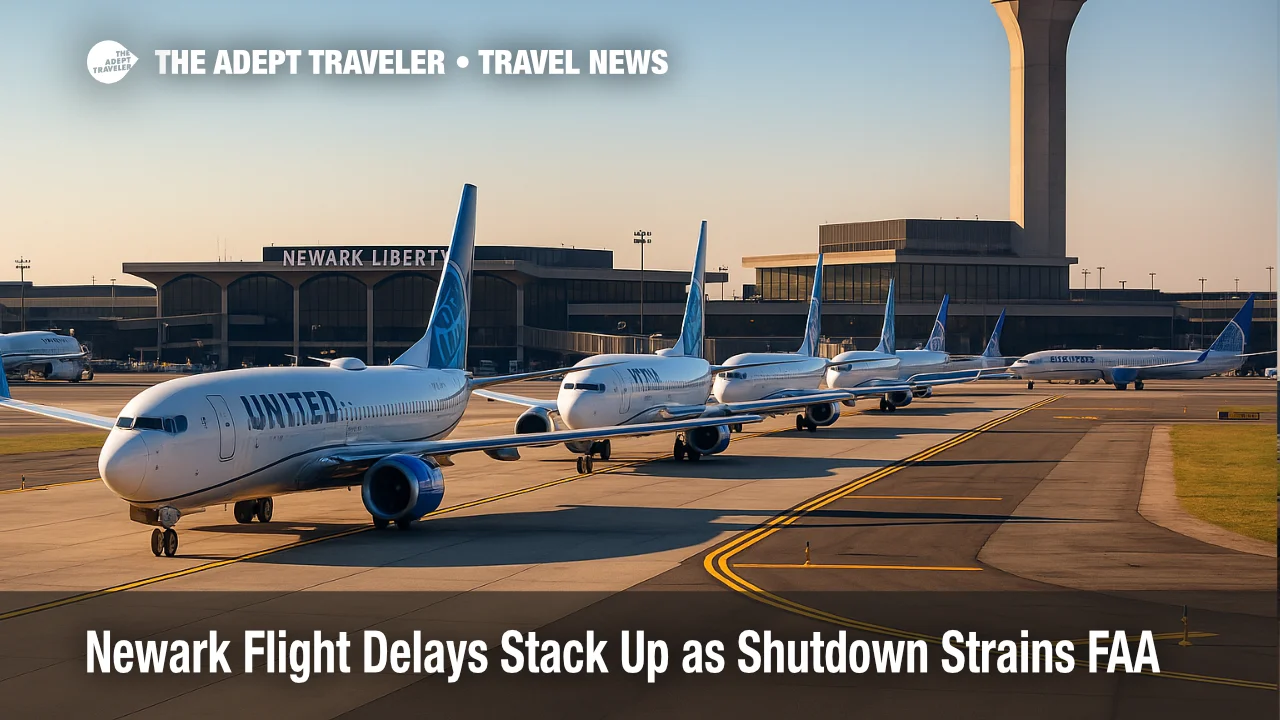Newark flight delays stack up as shutdown strains FAA staffing

Significant flight delays mounted at Newark Liberty International Airport (EWR) on October 9 as FAA "staffing triggers" forced controllers to meter traffic for safety. FAA advisories and live data showed periodic ground delays around 80 to 90 minutes at Newark, with knock-on holds into Boston Logan International Airport (BOS) and smaller New England fields. The uptick stems from thin controller coverage during the government shutdown, which requires essential FAA personnel to work without pay and has increased sick calls at some facilities, according to U.S. Transportation Secretary Sean Duffy.
Key points
- Why it matters: Newark's delays ripple through United's network and the Northeast corridor.
- Travel impact: Expect holds, ground delay programs, and longer taxi-out times during peaks.
- What's next: FAA continues surge hiring, but shortages persist while the shutdown continues.
- Newark's hourly movements remain capped under an FAA order through October 2026.
- Live FlightAware data showed thousands of U.S. delays by mid-afternoon October 9.
Snapshot
By early afternoon on October 9, FlightAware tallied more than 3,100 delays within, into, or out of the United States, reflecting both staffing and weather. FAA Strategic Plan advisories flagged controller "staffing triggers" at multiple facilities, prompting traffic-management initiatives that slow inbound flows to keep operations safe. Newark saw average ground delays near 90 minutes at times, while flights bound for Boston were held at origin for roughly 30 to 50 minutes. The FAA emphasized that when staffing dips, it meters arrivals and departures to maintain safety margins, and union leaders urged controllers to keep working despite missed paychecks. Travelers should build extra time into connections, favor morning nonstops, and monitor airline alerts.
Background
Newark endured lengthy queues in the spring due to a combination of weather, congested airspace, and controller shortfalls. To stabilize operations, the FAA limited scheduled operations per hour at EWR, a cap now extended through October 2026. Nationwide, DOT says controller ranks remain thousands below target despite an ongoing hiring push. During a Newark press event on October 6, Secretary Sean Duffy acknowledged a slight uptick in sick calls while praising the vast majority of controllers who continue to report. The National Air Traffic Controllers Association echoed that message, urging calm and adherence to procedures. While the shutdown persists, FAA plans indicate staffing-related metering may recur during peak banks, especially in the Northeast.
Latest developments
Newark flight delays and Boston ground holds intensify on October 9
FAA operations messages on October 9 referenced staffing triggers, including in the Philadelphia and Boston areas, which can pinch Northeast flows and contribute to Newark metering. Travel trackers showed Newark's average departure delays pushing toward 90 minutes at times, while Boston arrivals faced average holds near 48 minutes. By 2:58 p.m. EDT, FlightAware reported 16,285 total delays globally and 3,124 within, into, or out of the United States, with thunderstorms and winds adding to the burden. DOT reiterated that metering will continue as needed to preserve safety, and Secretary Duffy warned that persistent no-shows could face discipline under federal law. For travelers, that translates to variable waits, tighter bank recovery times, and a higher-than-usual risk of missed connections.
Analysis
Newark is among the most delay-sensitive hubs in U.S. aviation because of dense scheduling, runway geometry, and shared Northeast airspace. When FAA staffing dips at any linked terminal radar (TRACON) or tower in the region, programs like ground delay or airspace flow constraints quickly cascade across departure banks. The current shutdown accelerates those dynamics by nudging absenteeism upward, even as most controllers still report. FAA's long-term cap at EWR is helping, but the immediate constraint is people, not pavement. DOT's plan to add thousands of controllers through 2028 is necessary, yet training timelines mean little relief this month. Expect spotty, peak-time slowdowns at Newark and occasional holds into Boston and secondary airports such as Bradley International Airport (BDL) and Roanoke-Blacksburg Regional Airport (ROA) when nearby facilities post "thin coverage" windows. Until appropriations resume, the prudent play for travelers is earlier flights, longer connections, and carry-on-only flexibility.
Final thoughts
For the next several days, Newark flight delays may ebb and flow with weather and staffing. If you must connect, pad your itinerary, enroll in alerts, and consider rebooking to earlier departures. As FAA hiring ramps but the shutdown lingers, the Northeast will remain sensitive to staffing triggers. We will continue to track FAA advisories and FlightAware stats to spotlight when conditions improve or worsen at this critical hub for Newark flight delays.
Sources
- Current Operations Plan Advisory, FAA
- Live flight delay and cancellation statistics for today, FlightAware
- U.S. Transportation Secretary on airspace safety, C-SPAN
- NATCA President remarks at Newark press event, NATCA
- FAA extends Newark flight caps through October 2026, Reuters
- Newark flights delayed up to 90 minutes amid short staffing, TravelPulse
- U.S. delays, staffing context during shutdown, Reuters
